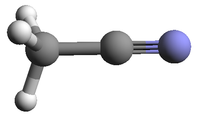|
The experimental data up to 40 GHz have been
reported by
(1) L. Halonen and I. M. Mills,
1978, J. Mol. Spectrosc. 73, 494.
The low symmetry of the molecule causes a small
c-dipole moment component. Several transitions
obeying c-type selection rules were reported,
facilitating predictions to higher frequencies.
Transition frequencies were reported in part to
kilo-Hertz digits and to ten kilo-Hertz digits, respectively.
The assigned uncertainties are 10 kHz for the
former, as stated in the article. The latter data appear
to be less accurate, and 50 kHz were assigned.
These uncertainties yielded a balanced fit, though the
latter may be slightly conservative.
With respect to the first entry from May 2011,
additional extensive millimeter and submillimeter
data have been reported by
(2) L. Nguyen, A. Walters, L. Margulès,
R. A. Motiyenko, J.-C. Guillemin, C. Kahane,
and C. Ceccarelli,
2013, Astron. Astrophys. 553, Art. No. A84.
Some of the higher Ka data were
already excluded from the fit in (2) because of
suspected perturbations with one or more low-lying
vibrational states. Here, all data above
Ka = 15 were omitted,
resulting in a somewhat different parameter set.
Predictions should be reliable throughout, at
least up to Ka = 15
or 16, well beyond the needs of astronomers.
Note: Non-trivial
spin-statistics do not matter for this
low symmetry (CS) isotopolog.
The dipole moment has been derived from the main
isotopolog, see e041505.cat, taking into account the
rotation of the inertial axes. The magnitude of the
c-component should be taken with some care.
|
